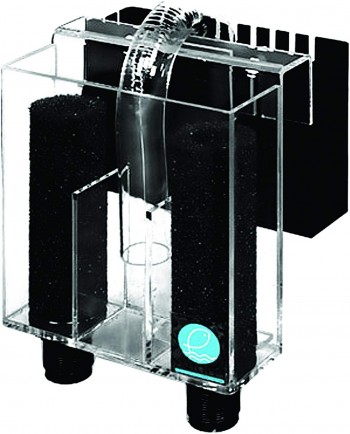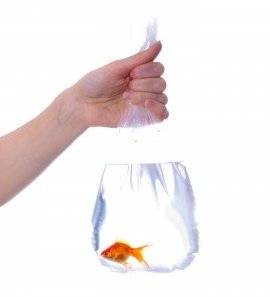Perhaps a Perfect Community Tank

With the new fishtank on your mantle, bubbling or pumping away, you are probably wondering what to put into it. Stocking a fish tank would easily be called the “fun part” of the hobby. Be sure to have achieved the following checklist with your new tank before buying the first fish:
- Temperature 76 degrees F
- pH balanced to Neutral not by accident, but by a chemical regulator
- Aeration and circulation vigorous, you can hear the fishtank from five feet away.
- Lighting is 12 to 14 hours on, rest off.
- Undergravel filtration
- Fully cycled biological system six weeks old or older.
Let’s discuss some back ground points on water quality before we get some fish.
About pH and hardness.
pH – a measure of the acidity or alkalinity of water. See also.
Hardness – a measure of the mineral content of water.
Most community tanks contain fish that like opposite types of water. What I mean is that some fish prefer Hard, Alkaline water, like the livebearer Platies, Mollies and Swordtails…. Unlike the Tetras, Discus, Rams, and other South Americans who prefer soft, semi-acid water.
When these fish get together, one type is bound to fail, depending upon how well they can adapt to inappropriate water conditions.
The hobbyist will see either the hardwater fish losing out to the softwater fish, or vice-versa, depending on the existing conditions, but it is hard to please everyone. (In fact, you basically can’t).
Most fish adapt somewhat, so I won’t say it’s impossible to keep Discus with Sailfin Mollies, for example, but if you look at their requirements, you will see that they are quite dissimilar.
If you choose fish from the following group, the incidence of fish loss, to either aggression or frailty, will be decreased.
- Gold barbs
- Platies
- Serpae and Bleeding Heaert Tetras
- Blue or Gold Gouramis
- Dwarf Gouramis
- Angel fish
- Kribensis Cichlids
- Clown Loaches
- Horseface Loaches
- Weather or Dojo Loaches
- Corydoras Catfish
- Plecostomus
- Zebra Danios
- Pearl Danios
- Pencil fish
- White Cloud Mountain Minnows
- Blue Acaras
- Singly: Redtail black sharks
- Singly in bowls: Paradise Gouramis, indestructible
- Frail fish:
- Kuhli Loaches
- Hatchet fish
- Neons
- Cardinals
- Ram Cichlids
- Bettas
The perfect community:
For ten gallons:
1 Plecostomus, 1 red tail black shark, 2-3 Cory catfish, 3 Gold barbs, 3 zebra Danios, 3 Platies, 1 Angel fish or a pair of Kribensis, 3-5 pencil fish. We had one Einstein mention that these fish grow up into larger fish and would eventually be crowded in such a tank. Another who has never kept more than an inch of fish per gallon of water and did not know it could actually be done with something called “filtration”.
For Twenty-to-Thirty Gallons:
3-5 Gold Barbs, 1-2 Angel fish, 1 Redtail Black Shark, 3 Serpae tetras, 3 cory catfish, 1-2 plecostomus, 3-5 Platies, 1 Blue Gourami, 1 Dwarf Gourami, 5 Pencil fish, 3 White Cloud Mountain Minnows, 1 Clown Loach, Live plants
Again, watch for water quality deterioration which might suggest that you’ve added too many fish. when fish grow to an uncomfortable size, consider a tank upgrade or thin the population.
One great key to success with a freshwater community is to add fish in small numbers over a month or two, and always be ready with the salt because each group of incoming fish could bring in a disease. You can stop this quickly if you salt according to accepted instructions.
Once you’ve got a healthy group of fish co-existing in harmony, you can start to remove the plastic plants and replace them with Live specimens.
Live plants may be of immense utility to you. They provide cover for the fish or fry, they are edible to most fish, even if not as a staple in the diet, and they use Nitrates.
It is true that they also give off oxygen, but they do this principally when the lights are ON. Once the lights turn off, the plants USE oxygen and give off CO2. This is only a detriment when the plants overcrowd the system.
I would recommend to you: Floating Wisteria, rooted Banana plants, Anachris in cool well lighted water, Aponegeton bulbs rooted in loamy sand, half the bulb buried. Some sword plants may be maintained, but you will find them expensive, and if they die, heartbreaking. You’ll need a pretty good bit of light to make plants happy. Choose Aponogeton bulbs for good first try success.
For real plant eaters like Plecostomus, you can simply bundle some bruised spinach and Zucchini and put that in the system. They will eat it hungrily.
I could recommend that you routinely change 20% of the water in that system every week or two.
It would be even better if you siphoned or hydrocleaned the gravel when you did the water change. This removes debris from the gravel that contributes to deteriorating water quality.
What technology is replacing “water changes?”

Please consider making routine water changes a part of your fish care protocol. And consider a siphon gravel cleaner as perhaps the most important advice you have ever received.
To correct a deranged water quality parameter like high ammonias or nitrites, a 33% waterchange daily using Dechlor, is essential until the tested parameter comes back to zero or nearly so.
When water is polluted, you would perform DAILY WATERCHANGES until the water is healthy.






